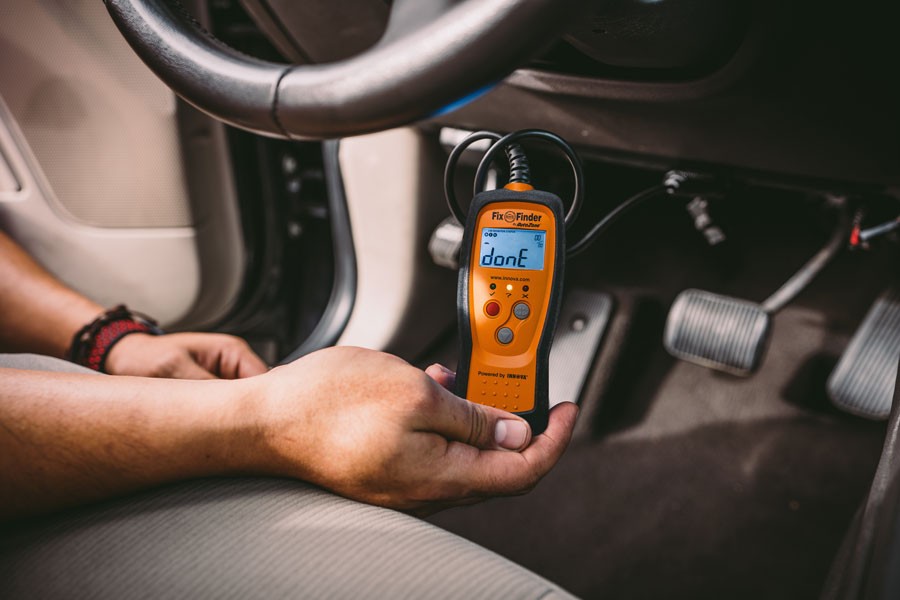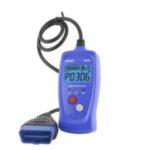Knowing how to use a hand-held OBD2 scanner can transform your approach to car maintenance. Instead of being in the dark when your check engine light comes on, you can take the first step towards understanding and potentially resolving the issue yourself. This guide will walk you through the process of using a hand-held OBD2 scanner, empowering you to diagnose car problems like a pro.
Connecting Your Hand-Held OBD2 Scanner
The first step in using your hand-held OBD2 scanner is to connect it to your vehicle. Thankfully, the process is straightforward and standardized across almost all modern cars and trucks. The OBD2 (On-Board Diagnostics II) port is the universal connection point for these devices.
For most vehicles, you’ll find the OBD2 port located beneath the dashboard on the driver’s side. It’s typically a 16-pin, trapezoid-shaped female connector. While the most common location is under the dash near the steering column, in some car models, it might be situated in the center console or even under the passenger side dashboard. If you are unsure, consult your vehicle’s owner’s manual for the exact location of the OBD2 port.
Connecting your hand-held OBD2 scanner is designed to be intuitive. The male plug on your scanner is shaped to fit the OBD2 port in only one orientation, ensuring a correct connection. Simply align the trapezoidal shape and gently but firmly push the scanner’s plug into the port. You might need to wiggle it slightly to ensure a secure and complete connection.
Here’s a quick checklist for connecting your OBD2 scanner:
- Turn Off the Ignition: Ensure your vehicle’s ignition is completely off before you begin.
- Locate the OBD2 Port: Find the port, usually under the driver’s side dashboard.
- Connect the Scanner: Match the shapes and firmly plug the scanner into the OBD2 port.
- Turn Ignition to ‘On’: Turn the ignition key to the ‘ON’ position. This powers up the car’s electronics without starting the engine.
- Wait for Scanner Boot-Up: In most cases, the OBD2 port will power your hand-held scanner. Give it a moment to boot up and initialize.
Once connected and powered on, your hand-held OBD2 scanner might prompt you for additional vehicle information. This could include engine size, VIN (Vehicle Identification Number), or instructions to start the engine. Follow the on-screen prompts to proceed.
Navigating the Menu Options of Your Hand-Held OBD2 Scanner
After your hand-held OBD2 scanner has successfully booted up and connected to your vehicle’s computer, you’ll be presented with a menu. The options available will vary depending on the capabilities of your specific scanner, ranging from basic code readers to more advanced diagnostic tools. However, common menu options you’ll likely encounter include:
Read Codes
This is the primary function for most users learning how to use a hand-held OBD scanner. Selecting “Read Codes” will instruct the scanner to communicate with your car’s computer and retrieve any stored or pending Diagnostic Trouble Codes (DTCs). These codes are alphanumeric identifiers that pinpoint potential issues within your vehicle’s systems. Along with the DTC number, some scanners may provide a brief description of the fault. If multiple codes are present, the scanner will typically scroll through them.
Erase Codes
The “Erase Codes” option allows you to clear stored DTCs from your vehicle’s computer memory. After you’ve addressed the issue indicated by a trouble code, you would use this function to reset the system and turn off the check engine light. Typically, the scanner will ask for confirmation before erasing codes to prevent accidental deletion. Be aware that erasing codes without fixing the underlying problem will only result in the codes and check engine light reappearing.
Live Data
For scanners equipped with live data capabilities, selecting this option lets you monitor real-time sensor readings from various systems within your car. This is incredibly useful for diagnosing intermittent problems or assessing the performance of components like oxygen sensors, MAF sensors, and more. By observing live data streams, you can identify sensors operating outside of their expected ranges or failing to respond correctly.
Freeze Frame
“Freeze Frame” data is a snapshot of vehicle parameters recorded at the exact moment a DTC was triggered. This valuable information can help you understand the conditions under which a fault occurred. Freeze frame data often includes parameters like engine speed, engine load, coolant temperature, and fuel trim, providing context to the trouble code and aiding in diagnosis.
Vehicle Info
The “Vehicle Info” or “Vehicle Information” option typically displays data related to your car’s build and identification. This might include the VIN, calibration IDs, and other vehicle-specific information retrieved from the car’s computer.
I/M Readiness
“I/M Readiness,” short for Inspection and Maintenance Readiness, is particularly relevant for emissions testing or smog checks. This menu section checks the status of various emission-related systems to determine if your vehicle is ready for testing. It can reveal if there are any pending issues that might cause your car to fail an emissions test.
Navigating these menus on your hand-held OBD2 scanner is usually done using directional buttons and selection buttons. Even basic scanners will have buttons to scroll through menu options and select your desired function. Many scanners also include a “back” or “escape” button to return to the previous menu screen.
Decoding OBD2 Trouble Codes
Once you use your hand-held OBD2 scanner to “Read Codes,” it will display a DTC. These codes might be accompanied by a short description, but often you’ll need to decipher the code yourself to fully understand the problem. OBD2 codes follow a standardized five-character format: one letter followed by four numbers, like P0301.
The first letter of the code indicates the primary system affected:
- P (Powertrain): Relates to the engine, transmission, fuel system, and emissions control systems. Powertrain codes are the most common.
- B (Body): Indicates issues with body control systems, including airbags, power windows, interior electronics, and comfort features.
- C (Chassis): Pertains to chassis-related systems like anti-lock brakes (ABS), traction control, suspension, and steering.
- U (Network/Communication): Signifies communication issues within the vehicle’s computer network, often involving multiple modules.
The numbers following the letter provide further details. The first number after the letter is always either a 0 or 1:
- 0: Indicates a generic code. These codes are standardized across all vehicle manufacturers and represent common OBD2 faults.
- 1: Signifies a manufacturer-specific code. These codes are defined by the car manufacturer and relate to systems or issues unique to that brand or model.
The third digit of the code specifies the subsystem:
- 1: Fuel and air metering system
- 2: Fuel and air metering – injector circuit
- 3: Ignition system or misfire
- 4: Auxiliary emission controls
- 5: Vehicle speed control and idle control system
- 7, 8, 9: Transmission related codes
- A, B, C: Hybrid powertrain system specific codes
The final two digits provide even more precise identification of the fault. With hundreds of possible combinations, these last digits pinpoint the specific component or circuit within the identified subsystem that is experiencing a problem.
Using our example code P0301, we can break it down:
- P: Powertrain system
- 0: Generic code (common to all manufacturers)
- 3: Ignition system or misfire
- 01: Specifically cylinder #1
Therefore, P0301 indicates a generic powertrain code related to an ignition system or misfire, specifically pointing to a cylinder #1 misfire.
Saving Money with a Hand-Held OBD2 Scanner
Owning and knowing how to use a hand-held OBD2 scanner can lead to significant savings on car repairs in several ways.
Firstly, when your check engine light illuminates or you experience a performance issue, a quick scan can provide valuable insights into the potential source of the problem. While it might not pinpoint the exact failed part, it gives you a crucial starting point for diagnosis, saving you from guesswork and potentially unnecessary repairs.
Secondly, as mentioned earlier, the I/M Readiness function can help you determine if your vehicle is likely to pass an emissions test. By checking this before going for a smog check, you can address any emission-related issues beforehand, avoiding potential test failures and re-test fees.
Perhaps the most significant saving comes from the ability to perform DIY repairs. For straightforward issues, a DTC obtained from your hand-held OBD2 scanner can guide you to the faulty component. For example, a P0138 code indicating a high voltage issue with bank 1 sensor 2 oxygen sensor often means a sensor replacement is needed. By diagnosing this yourself with a scanner and replacing the sensor yourself, you can save on both diagnostic labor costs at a repair shop and potentially reduce the overall repair bill.
Investing in a hand-held OBD2 scanner empowers you to take a more proactive and informed approach to car maintenance, potentially saving you money and hassle in the long run. Explore the range of OBD2 scanners available at obd2scanner.store and take control of your car diagnostics today.


